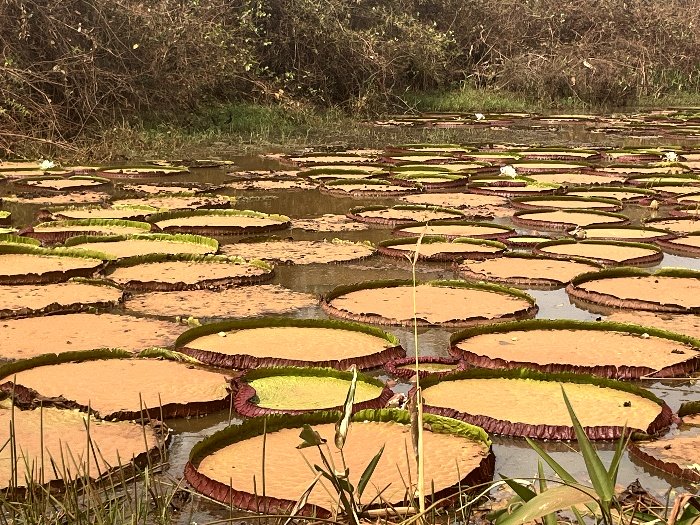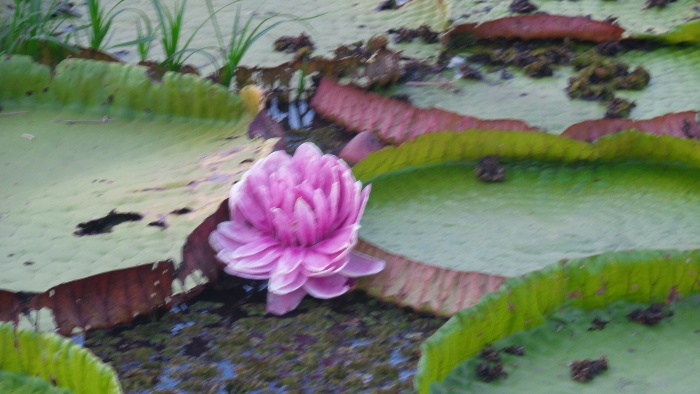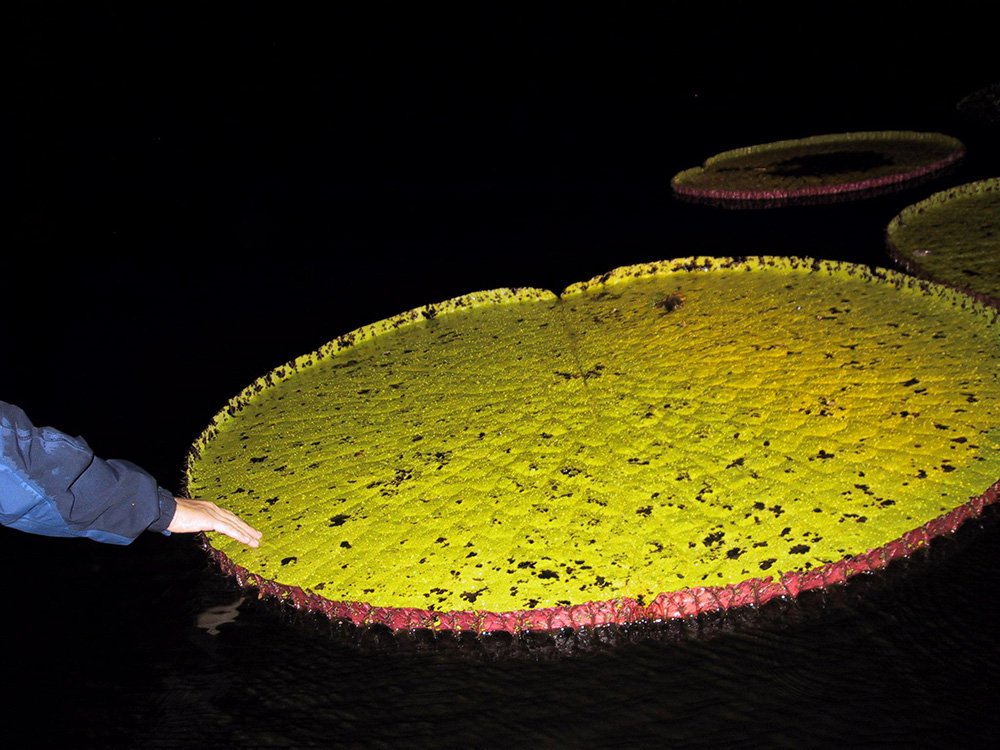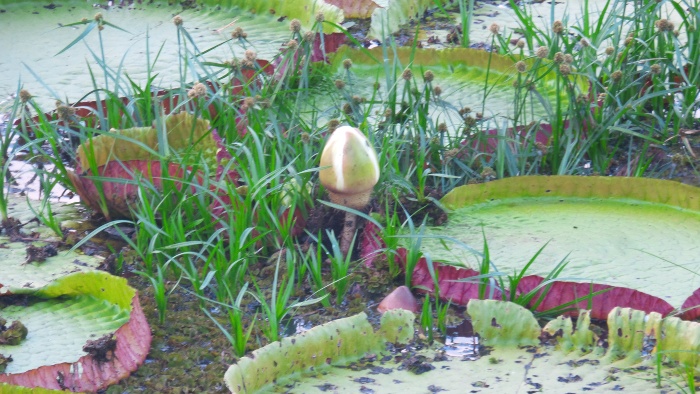Giant Water Lily
Victoria Boliviana
Giant Water Lily Victoria Boliviana
Nymphaea tetragona. The term water lily or lotus is generally applied to aquatic plants with flowers that grow in lakes, ponds, pools, swamps, or slow-moving streams, usually rooted in the bottom. Water lilies belong to the families Nymphaeaceae, Cabombaceae of the order Nymphaeales; the family Nelumbonaceae of the order Proteales and also to the genera Nymphoides of the family Menyanthaceae of the order Asterales and the genus Hydrocleys of the family Alismataceae of the order Alismatales. See each of these three families or one of these two genera for more specific data. The leaves of common water lilies can be of two types:
The first type is the one with the largest dimensions (usually). Their roots can reach lengths of 4.5 to 5 meters. The second type is the leaves that can be seen floating on the water. They are generally smaller in size.




New Species Victoria Boliviana
Spanish botanist Carlos Magdalena "Completely different" Botanist Carlos Magdalena, one of the world's leading experts on water lilies, had long suspected that the plant was different from the other two known giant species, Amazonian Victoria and Victoria cruziana.
Victoria boliviana IMAGE SOURCE,GETTY IMAGES His suspicions led him to ask scientists from Bolivia - from the National Herbarium of Bolivia, the Botanical Garden of Santa Cruz, and the Public Botanical Garden La Rinconada - for the donation of some seeds to the Royal Botanic Gardens, Kew. "Completely different" Botanist Carlos Magdalena, one of the world's leading experts on water lilies, had long suspected that the plant was different from the other two known giant species, Amazonian Victoria and Victoria cruziana.
Victoria boliviana
His suspicions led him to ask scientists from Bolivia - from the National Herbarium of Bolivia, the Botanical Garden of Santa Cruz, and the Public Botanical Garden La Rinconada - for the donation of some seeds to the Royal Botanic Gardens, Kew.
"Perhaps it's subjective, but of the three species, I think (the new one) has one of the most beautiful flowers," he added.
The Royal Botanic Gardens, Kew, has a long tradition of cultivating these plants: the Water Lily House was built in 1852 to display its collections.
Archive image of the Water Lily House
The giant water lilies - discovered in the 19th century - were a natural wonder of the time, and the genus was named after Queen Victoria of England. With the new species discovered, there are now three species of this type.
The new discovery shows that water lilies still hold some surprises, and scientists say there is still much to learn about them.
Victoria Boliviana in the wild in Bolivia
"None of the three species has been very well studied," explained scientist Alex Monro, from the Royal Botanic Gardens, Kew.
"We still don't know how many populations there are and how much they vary in size. We don't understand pollination biology very well. We don't know much about the species' dispersal: how it is transmitted from one place to another."
"So there are still many unknowns. And I think, because they are so large, so obvious, people haven't thought about studying them in such detail."
The description of this plant has been published in the journal Frontiers in Plant Science.

Itinerary
Giant Water Lily Victoria Boliviana
Giant Bolivian Victoria Water Lily
2 days 1 night
Starting and Ending in Trinidad, El Beni Bolivia
Day 1
Pick Up from your hotel or from the bus terminal at 8:00 AM to begin a 45-minute vehicle journey to a natural lagoon where the habitat of the new Bolivian Victoria water lily species is found.
Once we arrive at our destination, we walk for approximately 30 minutes around the lagoon to reach the location of the giant water lily. Depending on the time of year, we may approach and enter the water to be in closer contact with this Amazonian plant.
Lunch will be served either near the first visit site or in the city of Trinidad at a restaurant.
In the afternoon, we head to another lagoon where we can visit other plants of this new Bolivian Victoria species in their natural habitat. We always aim to find the most developed ones. The round trip may take 3 to 4 hours, depending on the route we take this time, as it can vary depending on the time of year and access conditions, but mainly on the state of our giant water lilies.
Dinner at a restaurant in the city of Trinidad.
Overnight stay at a natural reserve called Chuchini.
Day 2
Before breakfast, a short walk along the forest trails.
After breakfast
Guided tour through the jungle to see the flora and fauna of Chuchini (40 min.) Boat ride (30 min) on the 3 km long Chuchini lagoon to see alligators and the great variety of birds in the Chuchini sanctuary. Guided tour of the archaeological museum where pre-Columbian ceramic remains of the Moxos culture are exhibited (20 min). Use our pedal boats to navigate the lagoon on your own. Then you can explore the Chuchini reserve on your own, walk through the jungle, swim in the lagoon, observe the blue and yellow macaws, and relax in the hammocks.
Return to Trinidad and Drop off at your hotel / Bus Terminal or Airport.
End of our services to visit the Giant Bolivian Victoria Water Lily.
Home > Guided Tours In Bolivia> Giant Water Lily Victoria Boliviana